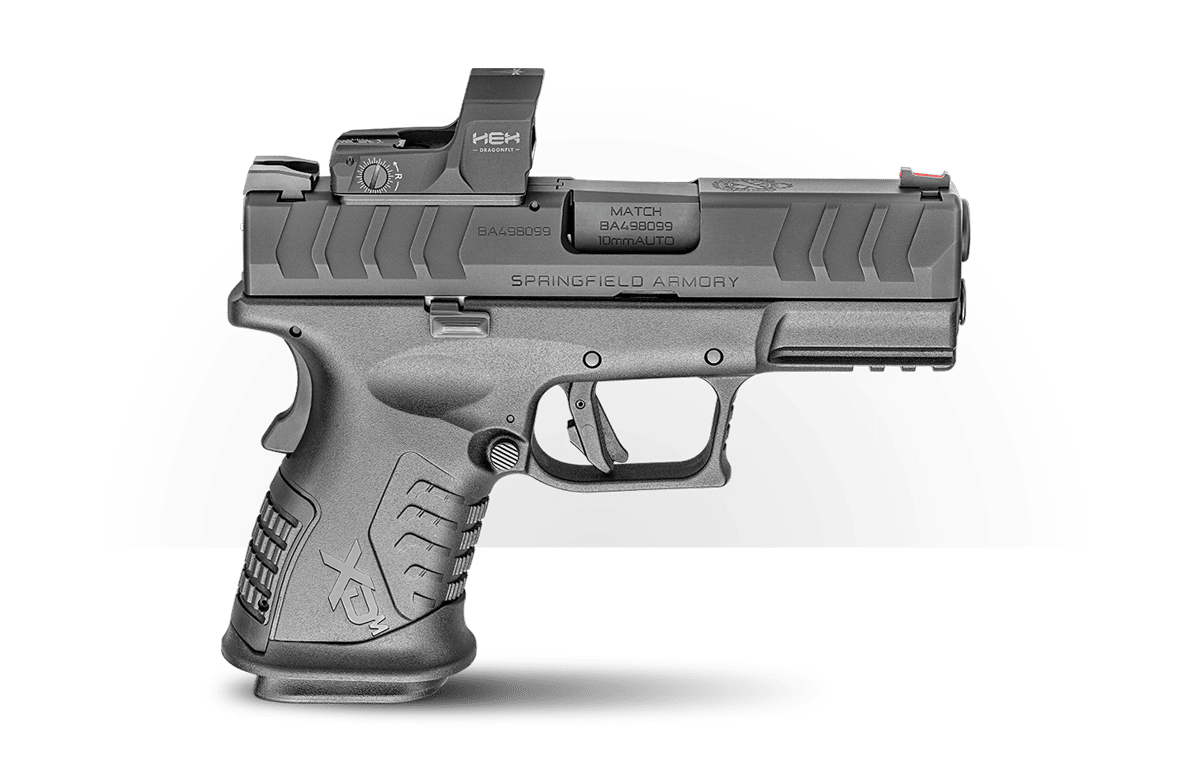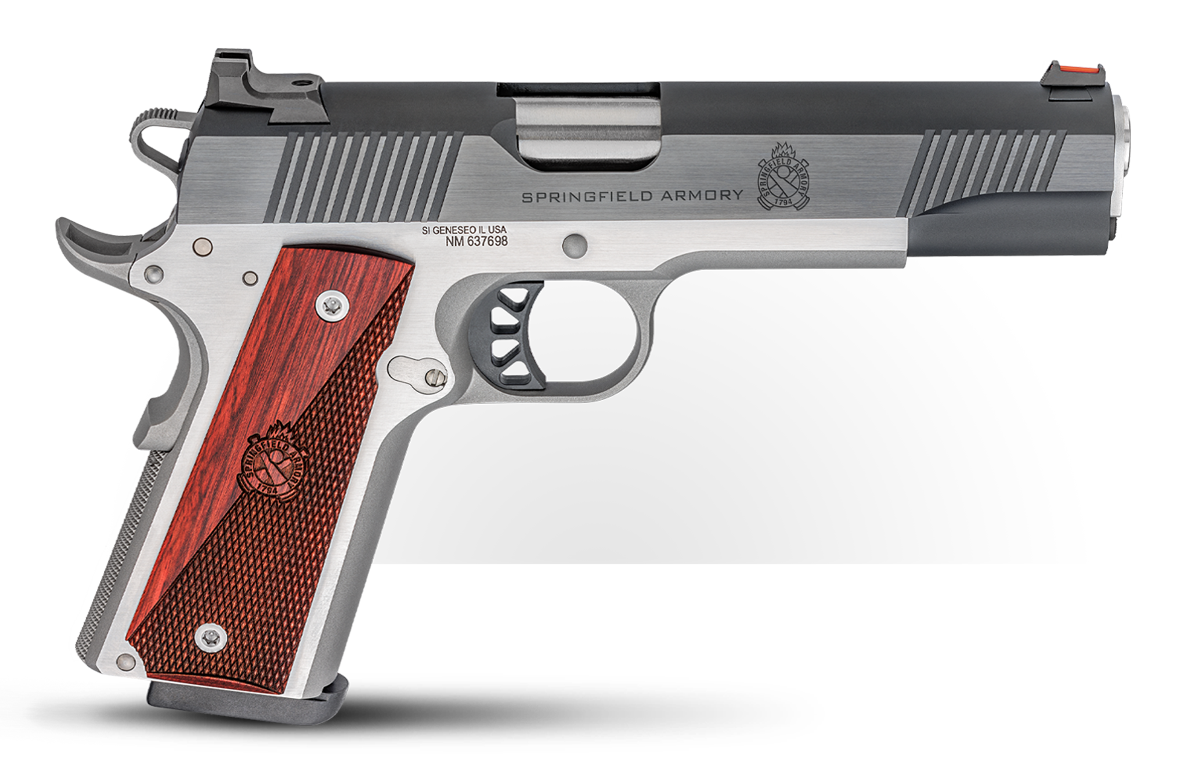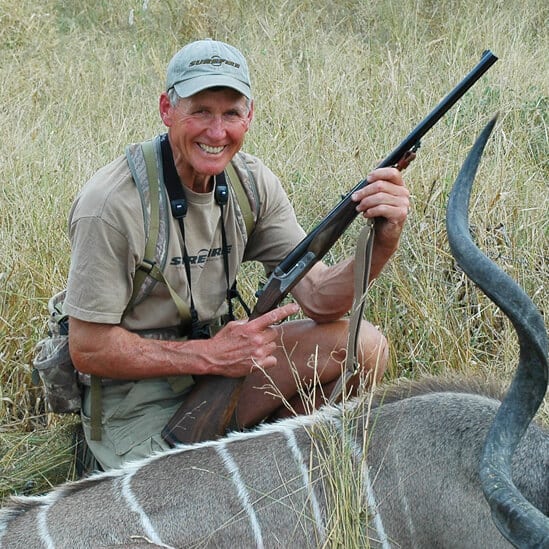.45 ACP vs. 10mm for Hunting
September 19th, 2022
9 minute read
Editor’s note: In this handgun hunting article, the author tackles the question of .45 vs. 10mm: which is the better choice? While both the 10mm and the .45 ACP have advantages, the author gives you some things to seriously consider before you make your decision.
He galloped in pursuit until “my good steed [brought me] alongside….” But then, as he “placed the muzzle of the revolver close to the body of the buffalo,” it spun to face him. Custer needed both hands to control his horse. In the chaos, he “discharged the pistol and sent the fatal ball into the very brain of the noble animal I rode.”
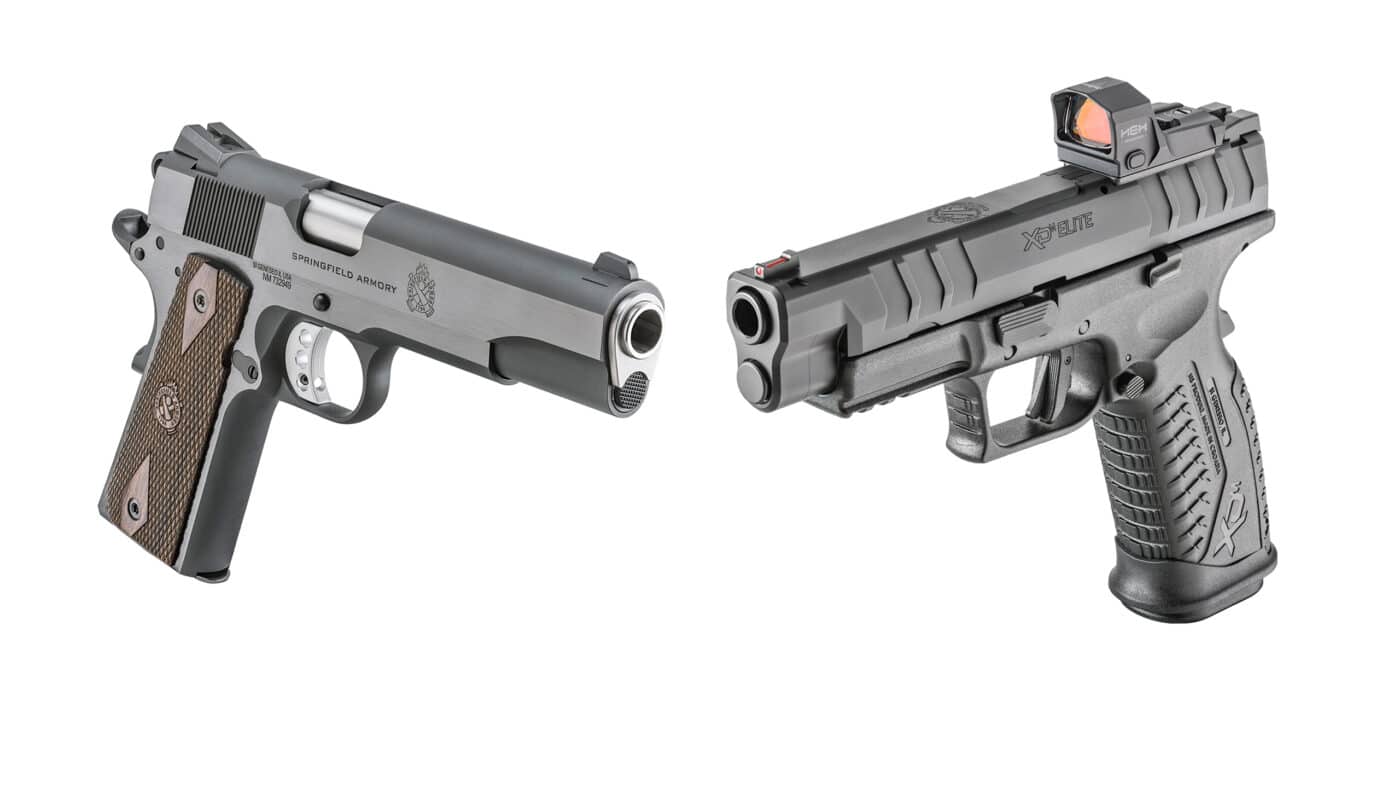
Four years earlier, in 1872, Russia’s Grand Duke Alexis had fared little better on a hunt with Bill Cody, putting spurs to his horse on a buffalo’s flank to empty a S&W revolver “without stirring a curl or arousing curiosity.” Eventually Alexis got the hang of it, reportedly killing eight buffalo, cripples omitted.
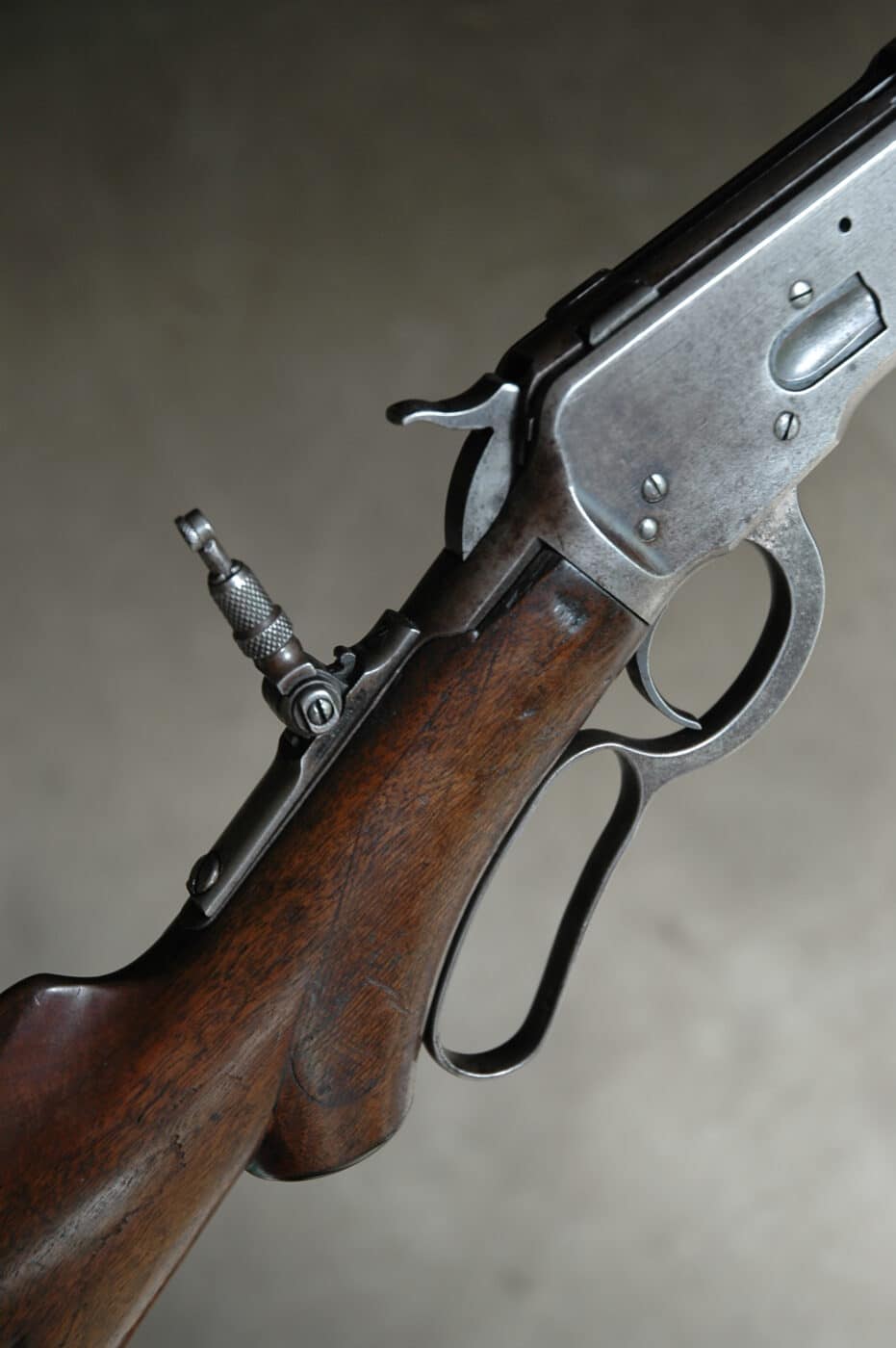
Market hunters used shoulder arms. “For general hunting,” wrote Cody to Winchester, “I pronounce [your 1873 rifle] the boss.” The 1873 held 15 of Winchester’s first centerfire cartridge. Fueled by 40 grains of black powder, the .44 W.C.F., or .44-40, sent 200-grain bullets at 1,310 fps from carbines. Other companies picked it up. Sam Colt so chambered his Single Action Army revolver too. In handgun barrels the .44-40 had nothing on the .45 Colt, but frontiersmen wearing a .45 needed different ammo for their rifles.
Fired by bandits and lawmen, the .44-40 cut a wide swath in the rowdy West. It also served hunters. Blunt lead bullets set practical shot limits at 100 yards or so. The .44-40 reached that far with 500 ft-lbs.
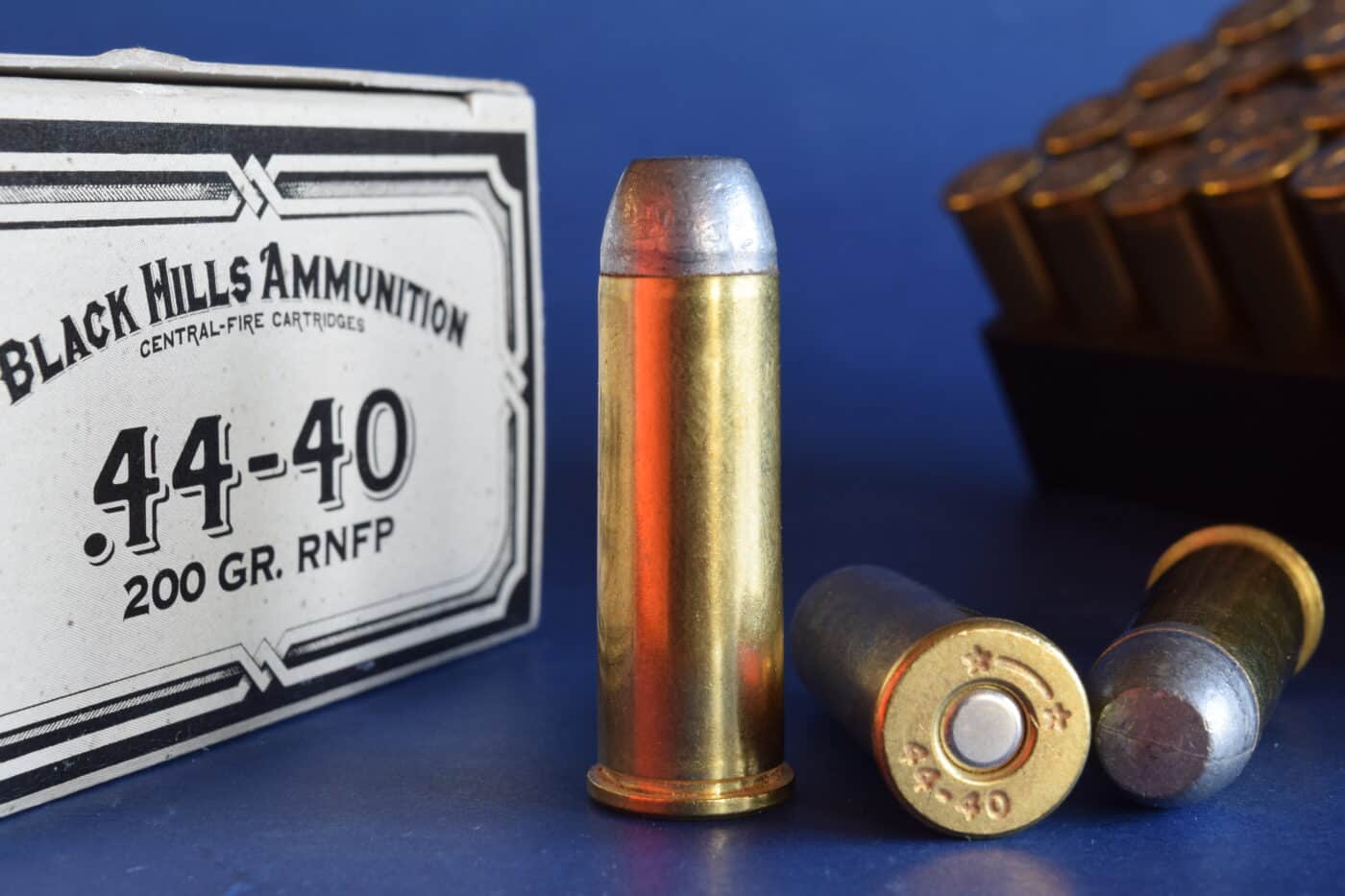
During the 1890s, smokeless loads in the likes of the .30-30 and .303 Savage gave hunters more zip. The .44-40 lost more market share in 1907 as the .44 Special, with its stouter case, blessed revolvers.
By the 1920s, buffalo hunts were history. Repeating carbines had buried heavy single-shot rifles. But Two-Pony and another cowhand had only a .38-40 Colt revolver when sent, on a wintry day, to find strays in a far place. According to the tale in a 1948 issue of Outdoor Life, they soon came upon grizzly prints. Rounding up most of the stock, they were forced by a storm to finish the job on snowshoes. Tracks led to a carcass. “Silvertip!” cried Two-Pony. The grizzly was on them in a rush. Two-Pony fired twice before he was “flung a dozen feet by a flailing paw.” His partner caught a blow to the face as he lunged for the revolver. Suddenly the bear was all teeth, gums and eyes. “Some other hand must have aimed … and pulled the trigger,” he recalled. The grizzly collapsed. Upon finding his partner dead, so did the bleeding cowhand. He would later learn his bullet had entered the bear’s chin and driven up into the brain.
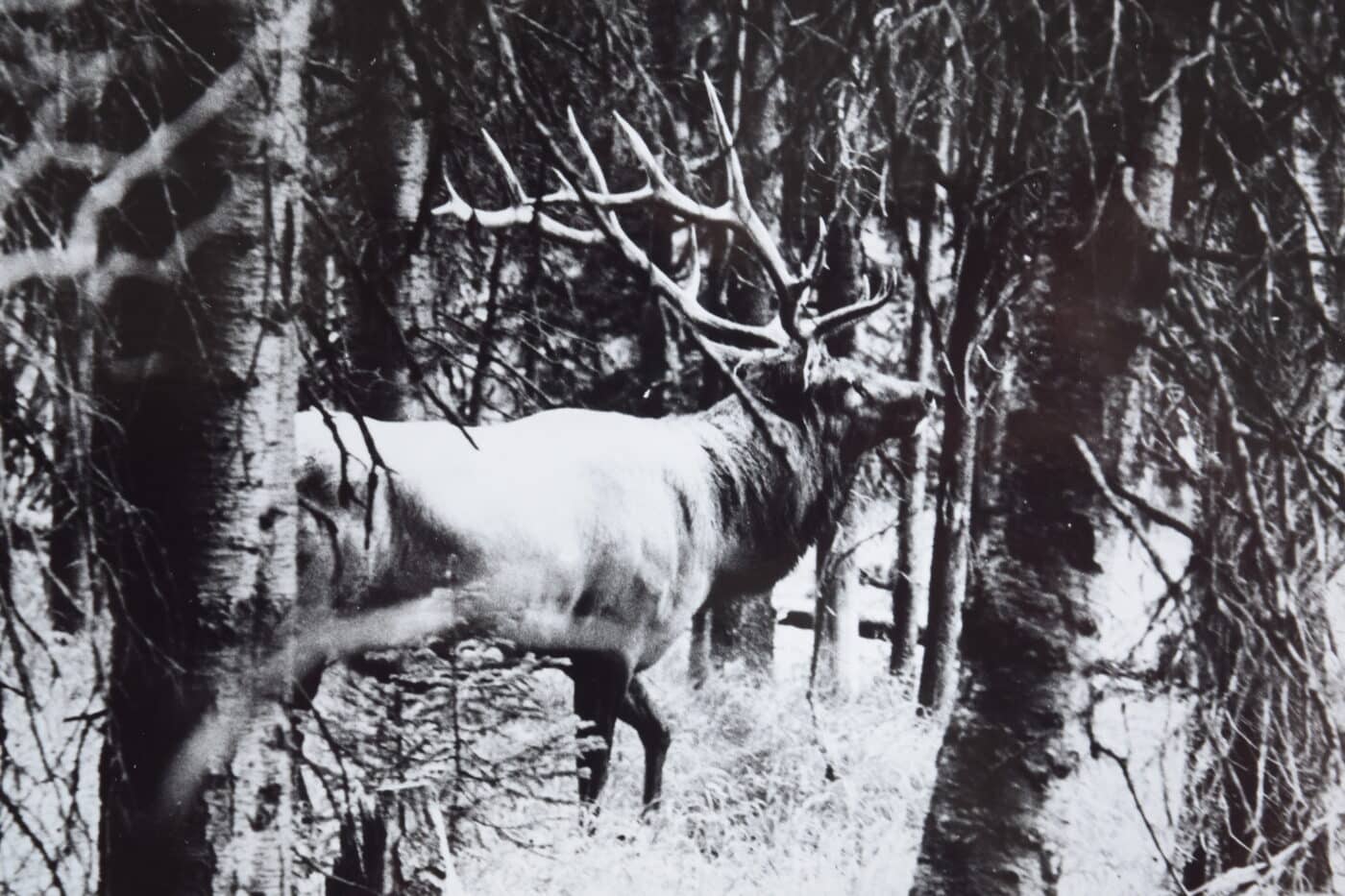
Elmer Keith’s post-war hunting exploits with handguns have been colorfully recorded. He found a .44 Special with 18.5 grains of 2400 powder effective on game as big as elk. “Up to at least 50 yards a good heavy six-gun load seems to kill as well as most .30-30 rifles.” Dick Casull would later prove that in modern brass and revolvers the .45 Colt will nearly match the moxy of the .44 Magnum — double that of .45 and .44-40 black-powder loads.
The Other Option?
Autoloaders haven’t been so blessed. Still, modern ammunition makes them much more capable than they were even 40 years ago.
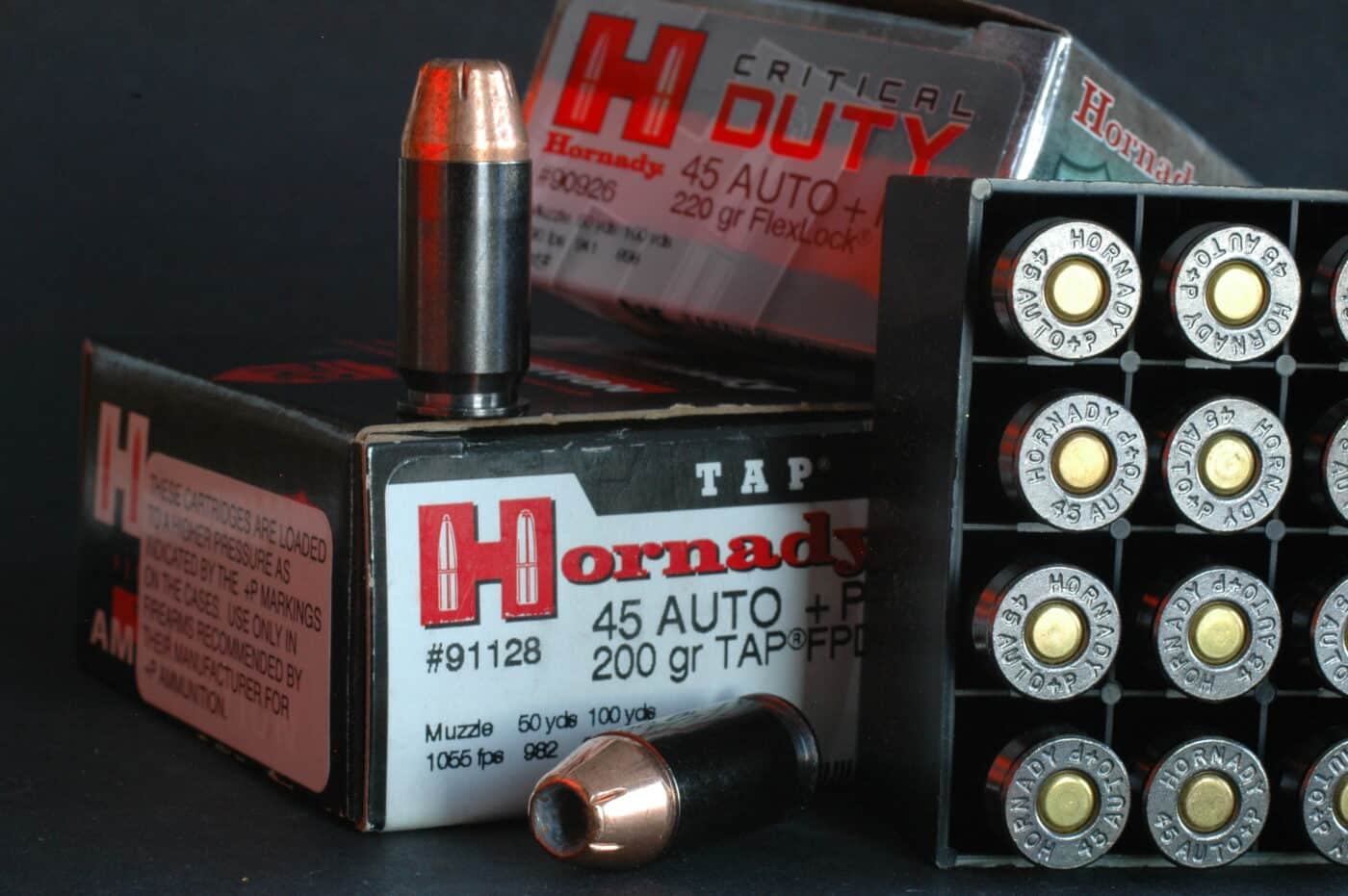
Among hunters’ few options in autos light enough for easy carry, none is more popular than the .45 ACP, none mightier than the 10mm Auto, introduced for the Bren Ten pistol in 1983. Bullets for the .45 ACP are .452 in diameter, those for the 10mm .400. Add the .40? Sure. Its case is .14 inch shorter than the 10mm’s, but it runs at about the same pressure (35,000 vs. 37,500 psi). Remington offers the .40 with165-grain JHPs to 1150 fps. They pack 480 ft-lbs, which Winchester claims with its 165-grain Defender load. Winchester’s 155-grain Silvertip HP eclipses the 500-ft-lbs mark. BHA stokes 115-grain Honey Badgers to 1325 fps, for 448 ft-lbs.
You needn’t have shot game with the .44-40 or .44 Special to concede bullet weight and diameter get less than their due in energy figures. Killing power can’t be distilled to foot-pounds, more easily hiked by velocity than by mass. Big, heavy bullets make reliably big entry holes and carry more momentum into bones. For hunting, Keith preferred his .44 Special loads to .357 Magnum ammo. At speeds throttled by the length and strength of handguns, his reasoning makes sense. Some loads for big-bore autos land deer-killing punch.
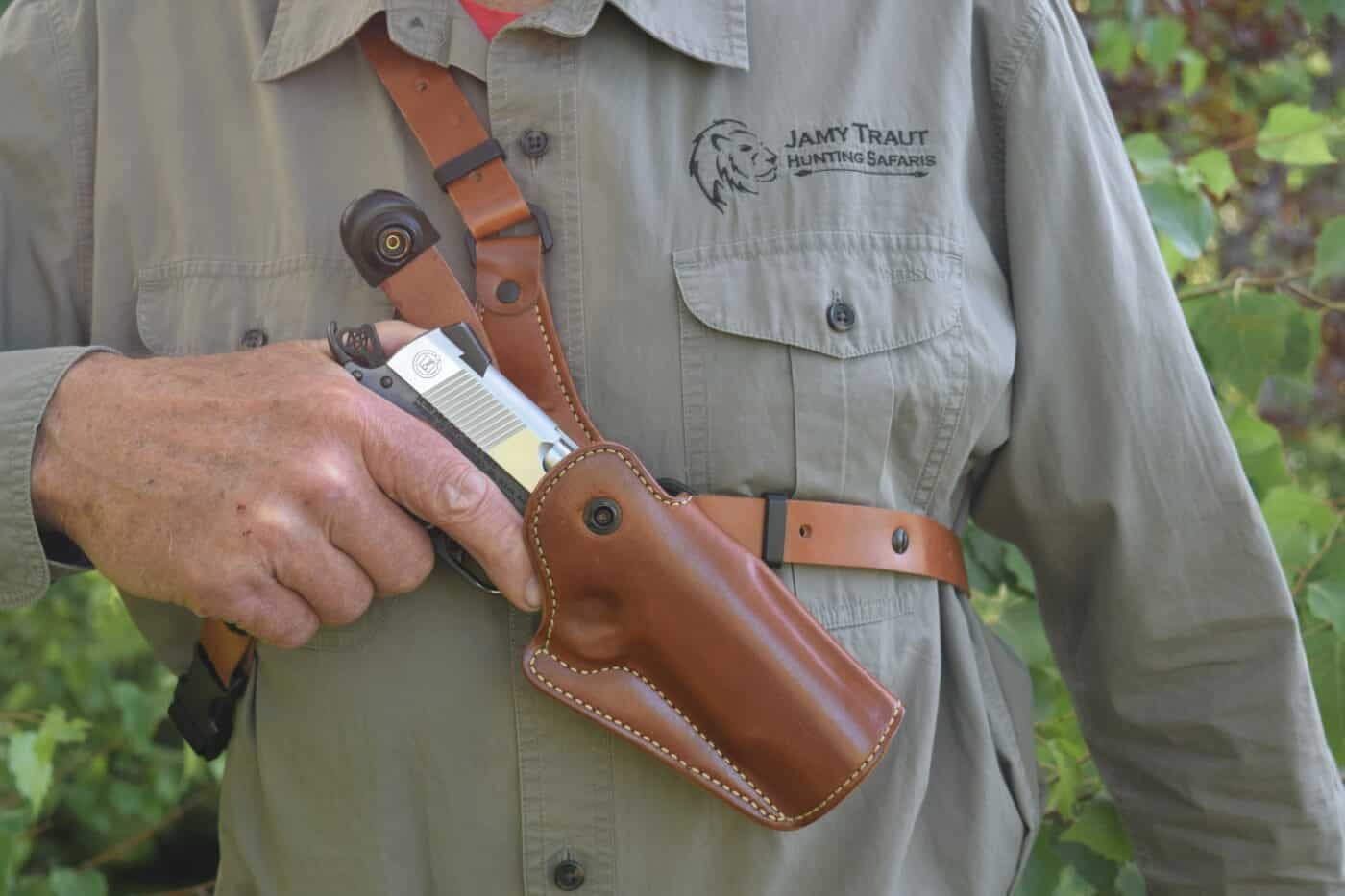
Why pick an auto over a revolver? Well, autos hold more bullets. Though on a hunt you shouldn’t need a big reserve, more bullets are a comfort if the sidearm must double as a bear-stopper. Self-loaders lie flat, which can be an advantage in packing a handgun, especially for chest-carry. That’s the best place if you need the pistol to defend yourself. Heavy hunting jackets slow your draw from a belt, and if a bear knocks you down, your hand will naturally and most easily go to your chest. On the ground, you can still reach your chest. I like Galco’s Great Alaskan chest holster. A custom version from Falco (yes, just one letter different) also tops my list. Both keep the pistol secure, handy and easily shielded by your jacket or rain gear from weather.
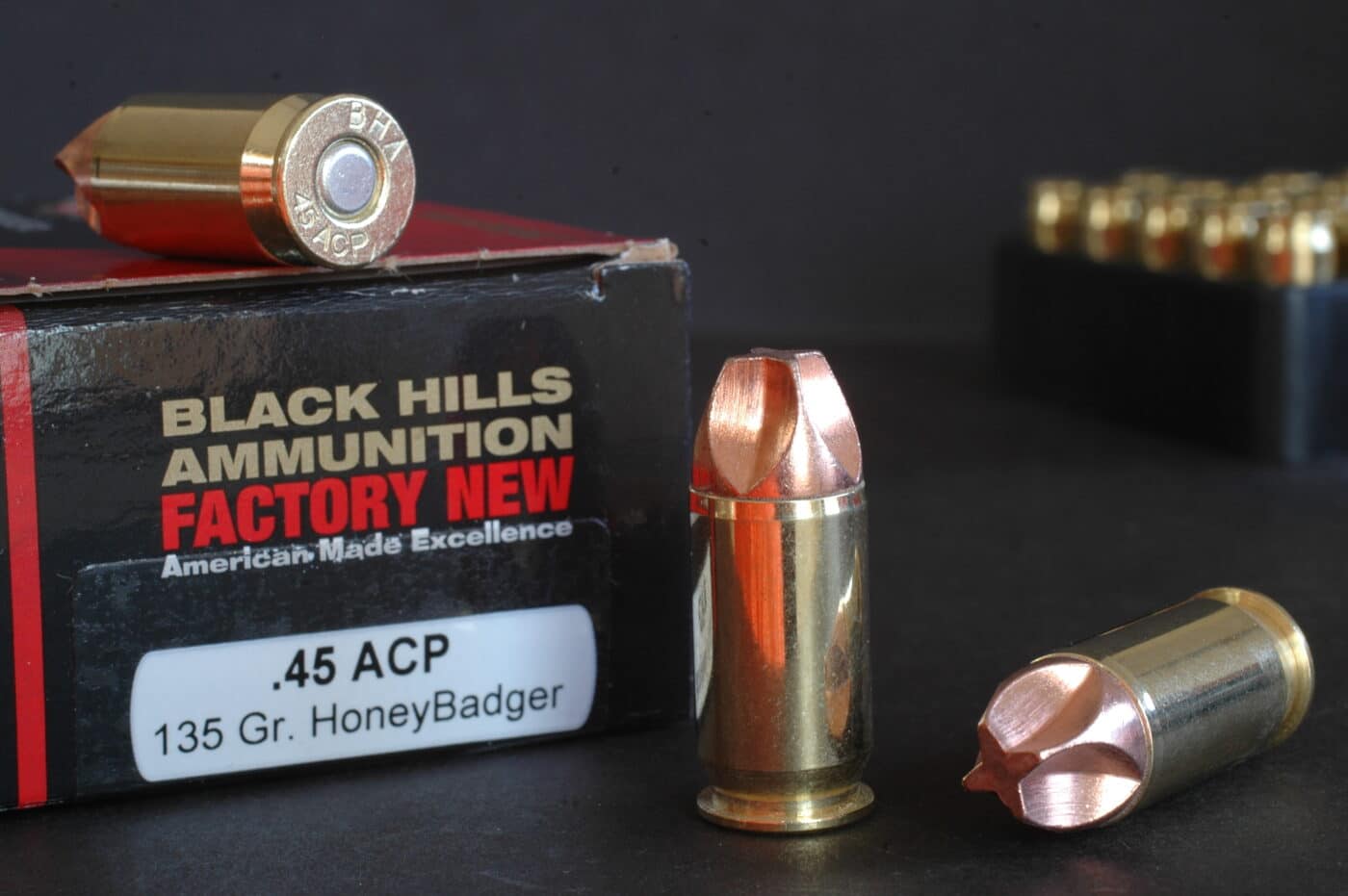
Autos can be fitted with any sight. A red-dot is as easily installed on a slide as on a top-strap. If you expect to shoot far, a scope is arguably better, and it’s easier to mount on a revolver. But to shoot far, you’ll probably want the reach of a cartridge best suited to revolvers or single-shots.
The issue of reliability, often cited as a reason to pack a revolver in bear country, has lost its fizz. Pistols like XDs and 1911s from Springfield Armory cycle with sunrise certainty. I have a 10mm XD-M Elite with a 3.8-inch barrel, an 11-shot magazine in its short grip. The Hex Dragonfly red dot sight adds little bulk but affords more precise aim. It’s also faster than iron sights against poorly defined targets. The Springfield Ronin (.45 or 10mm) is a comely, capable 1911, a perfect match for a chest holster.
Impressive Power
While the .45 ACP dates to the Model T, and the 10mm Auto barely beat Teslas to market, stiff loads from both will serve hunters. With both, bullet upset is desirable, penetration a must. Round-nose FMJs cut long channels but can wander. (From rifles, too, flat bullet noses seem to track straighter, shatter bone more violently and drive as deep.) For most thin-skinned creatures, I prefer beefy expanding bullets fashioned to retain weight while blasting a broad cavity from 4 to 10 inches inside deer-size game.
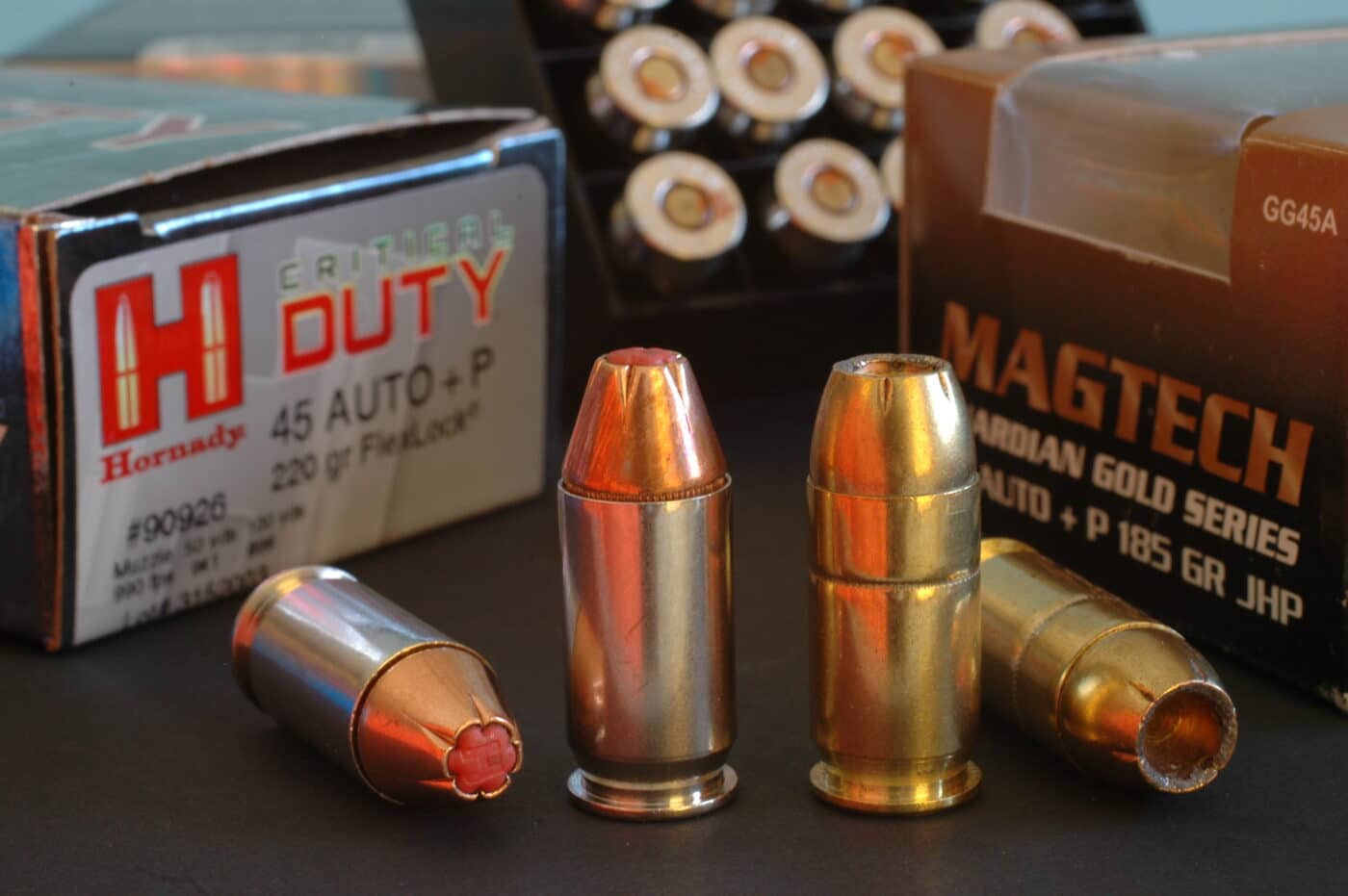
While the 10mm has a ballistic edge, .45 aficionados need not apologize. The .45’s long tenure has brought it a cornucopia of useful loads. Velocities for these were taken from 4 ¼ to 5 ½-inch barrels:
Winchester carbine. These figures are from 5- and 5 ½-inch barrels:
| Muzzle | 50 Yards | 100 Yards | |
| .45 ACP +P, 185-gr. Black Hills Barnes XP | |||
| – Velocity, fps | 1000 | 939 | 893 |
| – Energy, ft-lbs | 411 | 360 | 326 |
| .45 ACP +P, 230-gr. Black Hills JHP | |||
| – Velocity, fps | 950 | 908 | 871 |
| – Energy, ft-lbs | 461 | 421 | 388 |
| .45 ACP, 165-gr. Federal Hydra-Shok | |||
| – Velocity, fps | 1060 | 976 | 912 |
| – Energy, ft-lbs | 412 | 349 | 305 |
| .45 ACP, 210-gr Federal Hydra-Shok Deep | |||
| – Velocity, fps | 980 | 927 | 882 |
| – Energy, ft-lbs | 448 | 400 | 363 |
| .45 ACP, 230-gr. Federal Hydra-Shok | |||
| – Velocity, fps | 900 | 865 | 832 |
| – Energy, ft-lbs | 414 | 382 | 354 |
| .45 ACP, 230-gr. Federal JHP | |||
| – Velocity, fps | 890 | 856 | 824 |
| – Energy, ft-lbs | 404 | 374 | 347 |
| .45 ACP, 185-gr. Hornady XTP | |||
| – Velocity, fps | 970 | 911 | 862 |
| – Energy, ft-lbs | 386 | 341 | 305 |
| .45 ACP +P, 220-gr. Hornady FlexLock | |||
| – Velocity, fps | 975 | 927 | 887 |
| – Energy, ft-lbs | 464 | 420 | 384 |
| .45 ACP +P, 230-gr. Hornady XTP | |||
| – Velocity, fps | 950 | 908 | 871 |
| – Energy, ft-lbs | 461 | 421 | 388 |
| .45 ACP, 185-gr. Remington Brass-JHP | |||
| – Velocity, fps | 1015 | 951 | 898 |
| – Energy, ft-lbs | 423 | 372 | 329 |
| .45 ACP +P, 185-gr. Remington Brass-JHP | |||
| – Velocity, fps | 1140 | 1042 | 970 |
| – Energy, ft-lbs | 534 | 446 | 386 |
| .45 ACP. 230-gr. Remington Bonded Brass-JHP | |||
| – Velocity, fps | 875 | 833 | 802 |
| – Energy, ft-lbs | 391 | 354 | 321 |
These are just a sampling from major ammo makers. Winchester lists 14 in .45 ACP, including a 185-grain Silvertip at 1000 fps, a 230-grain Defender at 920. Barnes also stokes its 185-grain +P Tac-XP bullet to 1000 fps. A notable outlier is the 135-grain Black Hills Honey Badger. This fluted copper bullet exits at 1250 fps with 448 ft-lbs. It drives straight, burrows deep, leaves a cavity of surprising diameter.
To my mind, the .45 ACP is a 75-yard cartridge. Still, it’s deadly on deer at woods ranges, and, in better hands than mine, capable of hits to the vitals beyond 75 steps.
Less, and More
The 10mm extends effective reach. I initially doubted the 10mm XD-M Elite would be fun to fire.
After all, it pushes pressure over 37,500 psi, compared to the .45’s listed 21,000 (23,000 for +P loads). A range session, however, changed my mind. The XD-M’s double-stack magazine bumped grip dimensions up to fit my hand perfectly.
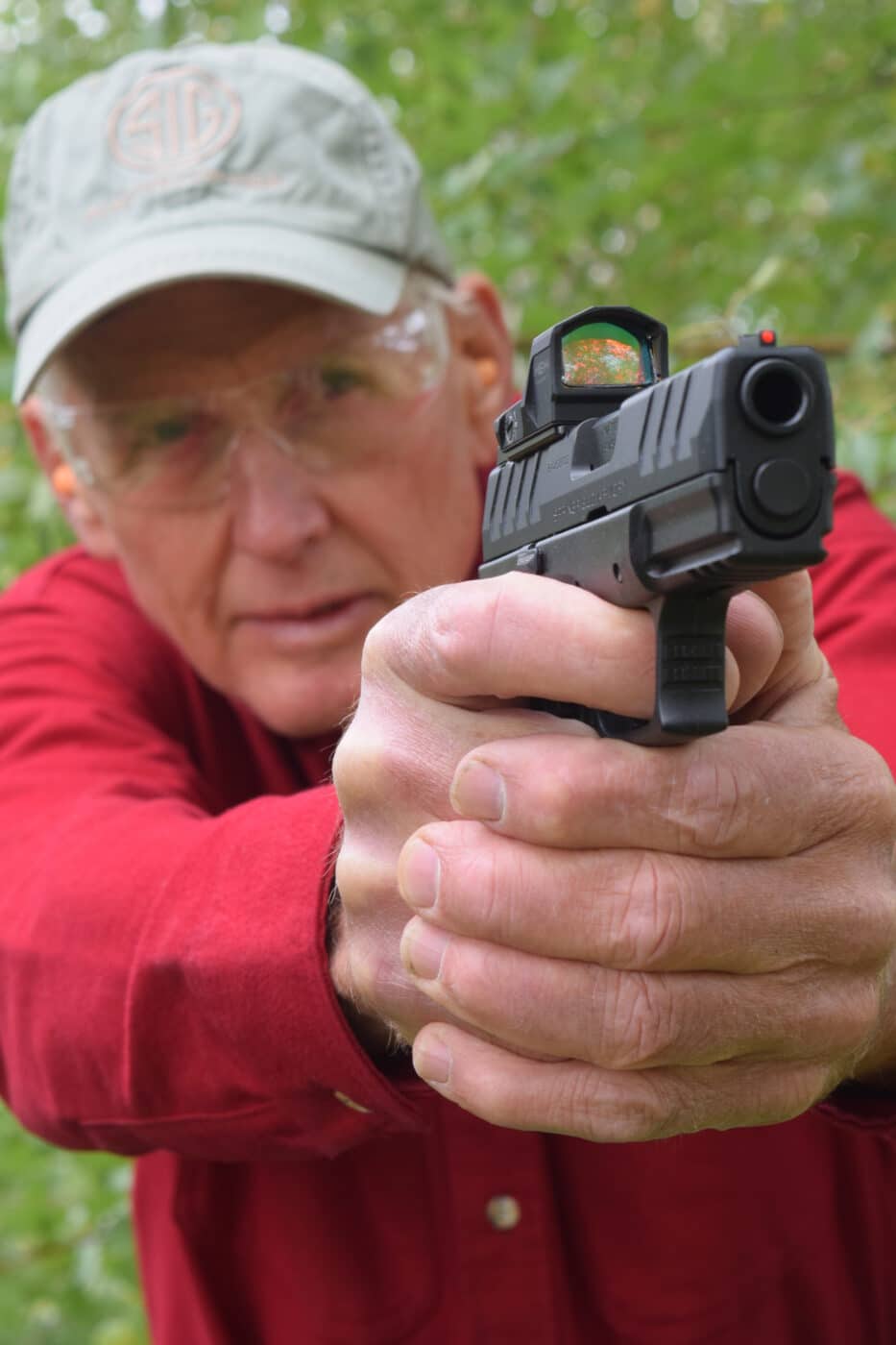
Excellent balance gives this pistol a nose for the target. Federal, Hornady and Winchester loads cycled perfectly. At 25 yards, three of five holes touched in a triangle that corralled four shots inside 1.4 inches. (Yes, I nudged the fifth out!) Springfield Armory’s 1911 Ronin gobbled the same loads eagerly, its slimmer grip adding a bit of sting in recoil.
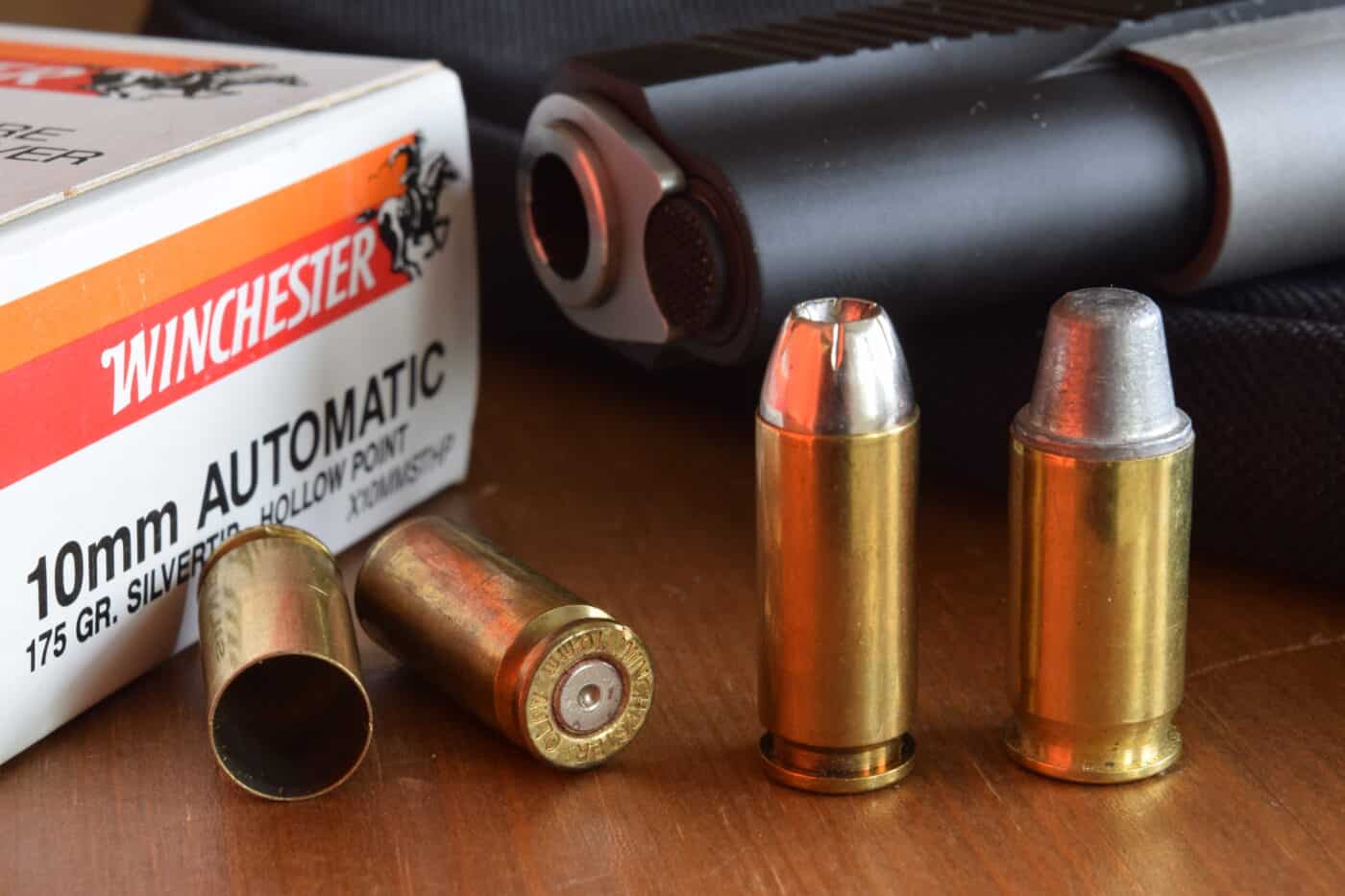
The 10mm Auto has almost as much moxy from a pistol as the .44-40 once delivered from a ‘73 Winchester carbine. These figures are from 5- and 5 ½-inch barrels:
| Muzzle | 50 Yards | 100 Yards | |
| 10mm, 180-gr. Federal FMJ | |||
| – Velocity, fps | 1030 | 970 | 921 |
| – Energy, ft-lbs | 424 | 376 | 339 |
| 10mm, 180-gr. Federal Hydra-Shok | |||
| – Velocity, fps | 1030 | 970 | 921 |
| – Energy, ft-lbs | 424 | 376 | 339 |
| 10mm, 180-gr. Federal Trophy Bonded | |||
| – Velocity, fps | 1275 | 1123 | 1021 |
| – Energy, ft-lbs | 650 | 504 | 417 |
| 10mm, 200-gr. Federal HST | |||
| – Velocity, fps | 1130 | 991 | 902 |
| – Energy, ft-lbs | 567 | 436 | 361 |
| 10mm, 135-gr. Hornady MonoFlex | |||
| – Velocity, fps | 1315 | 1108 | 985 |
| – Energy, ft-lbs | 518 | 368 | 291 |
| 10mm, 155-gr. Hornady XTP | |||
| – Velocity, fps | 1410 | 1224 | 1090 |
| – Energy, ft-lbs | 684 | 516 | 409 |
| 10mm, 175-gr. Hornady FlexLock | |||
| – Velocity, fps | 1160 | 1061 | 990 |
| – Energy, ft-lbs | 523 | 437 | 381 |
| 10mm, 180-gr. Hornady XTP | |||
| – Velocity, fps | 1275 | 1146 | 1052 |
| – Energy, ft-lbs | 650 | 525 | 443 |
| 10mm, 200-gr. Speer TMJFN | |||
| – Velocity, fps | 1050 | 985 | 933 |
| – Energy, ft-lbs | 490 | 431 | 387 |
| 10mm, 200-gr. Speer Gold Dot | |||
| – Velocity, fps | 1100 | 972 | 887 |
| – Energy, ft-lbs | 537 | 420 | 350 |
Other companies catalog 10mm Auto loads. Barnes offers a 155-grain XPB at 1150 fps, PMC a 170-grain hollowpoint at 1200 and a 200-grain truncated-core FMJ at 1050. Remington’s 180-grain FMJ clocks 1150 fps, Winchester’s 180 FMJ flat-nose 1080. Winchester also offers a 175-grain Silvertip HP at 1200 fps, and a 180 Defender at a 1240.
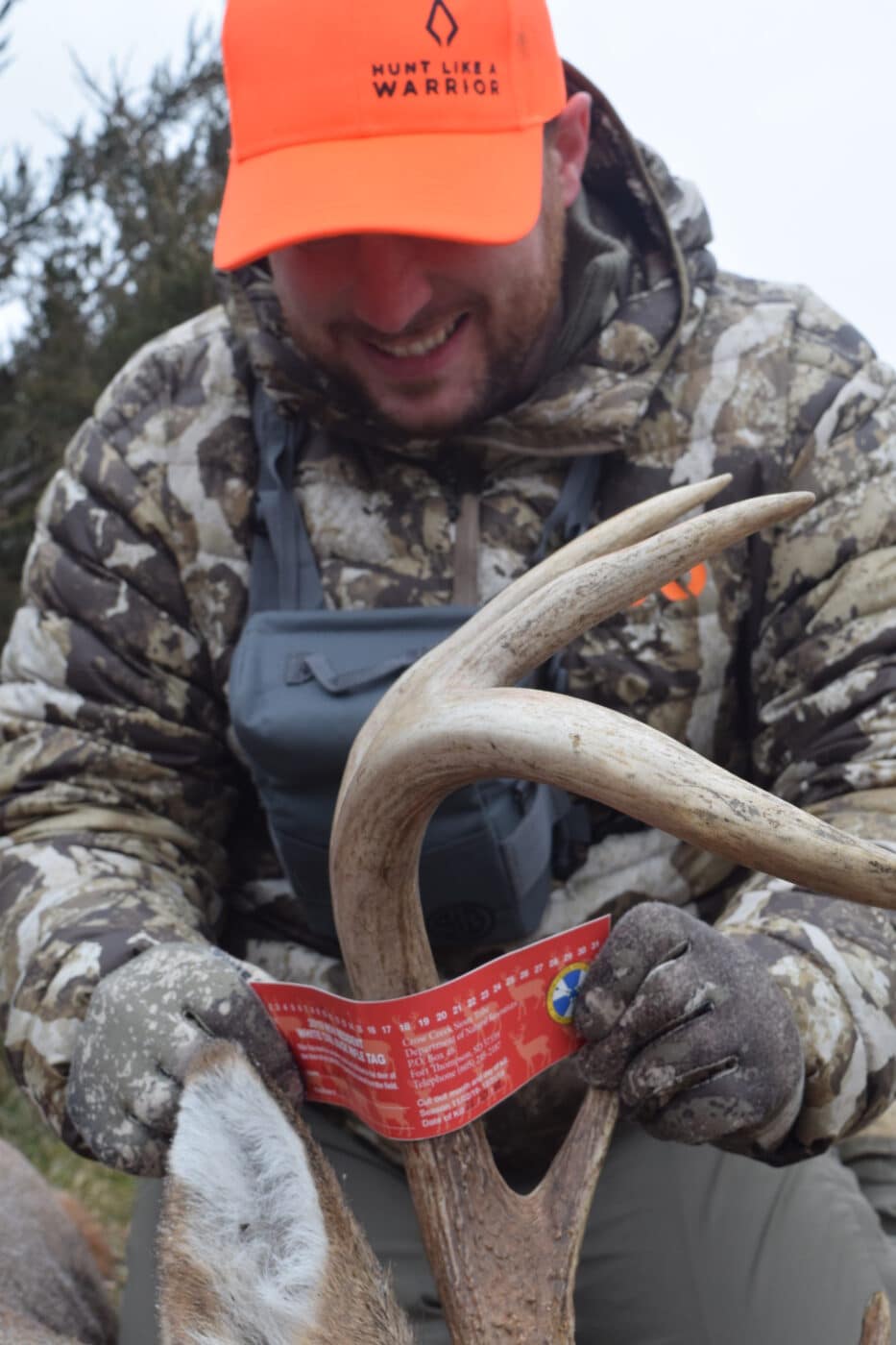
A stand-out is BHA’s recent 115-grain Honey Badger load at a scorching 1664 fps. So while .45 ACP ammo is easier to find and comprises a mind-numbing cornucopia of loads, the 10mm offers many options for handgun hunting. Its higher cost, stiffer recoil and more limited hosting in pistols are the fees you pay for a powerful, efficient .40.
Conclusion
Not long ago, a man with a revolver and a rifle in .44 W.C.F. was well armed, a formidable foe and a hunter of means. In handguns, the .45 ACP ably supplants the .44-40 and 19th-century .45 Colt loads. The 10mm Auto can bring a bit more game-killing punch on slightly flatter arcs.
Editor’s Note: Be sure to check out The Armory Life Forum, where you can comment about our daily articles, as well as just talk guns and gear. Click the “Go To Forum Thread” link below to jump in!
Join the Discussion
Featured in this article
Continue Reading
Did you enjoy this article?

 326
326




